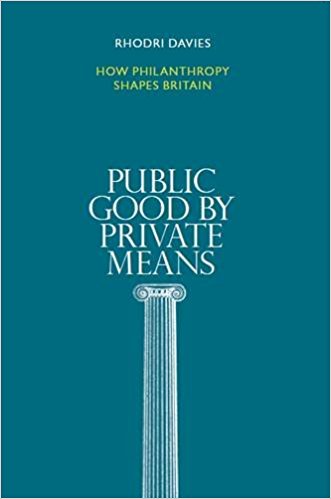
Rhodri Davies is the head of “Giving Thought”, the in-house think tank of Charities Aid Foundation. He believes that, “Although philanthropy is growing in prominence, there is still a real lack of clarity about its overall role in our society” (page 7) and in Public Good by Private Means he seeks to affirm its continuing role and clarify what that role is. The result is an interesting, though provoking and readable book that could assist people who wish to provide material support for charity or wish to influence public policy. Unfortunately, however, the book suffers from a number of deficiencies, which diminish its overall impact.
The most fundamental of these deficiencies relates to the thing that Davies is analysing. He expressly declines to give a precise definition of “philanthropy” (page 8). Instead, he says that he considers “the characteristics that typify philanthropy in its modern form” (page 8) and he leaves us to absorb his understanding as we read on. He distinguishes medieval religious alms giving “where the focus was primarily on what it meant for the donor and their immortal soul” from modern philanthropy, which he regards as giving “focussed on addressing the problems of society” (page 8) and it is clear that he does not have religious motivation or giving to religious causes in mind. Furthermore, although there is some discussion of support for the arts and education (e.g. page 99ff), it is clear that he is thinking mainly of the alleviation of poverty in much of his discussion. Indeed, his focus appears to be primarily on poverty in the UK (and, to some extent, the USA) rather than in the world as a whole.
Of course, an author may define his subject as he pleases. However, it is questionable whether Davies’ restricted focus is helpful and, more seriously, his lack of precision leads to conclusions that, on their face, appear to apply to a broader range of charitable activity than is justified by his arguments.
Parts of the book are tightly argued but Davies has a tendency to make sweeping assertions that lack support. For example, he asserts that “Philanthropy, properly understood, is about trying to improve society by tackling the root causes of problems, rather than just addressing their symptoms” (page 12) and thereby, dismisses disaster relief from its ambit. Likewise, a few lines later, he asserts that “tolerance for risk is one of philanthropy’s greatest assets” and later rhetorically asks “If philanthropy is unwilling to break the bounds of convention or afraid to think beyond the status quo, then what is the point of it?” (page 173). Whilst few would deny that there is a place for risk taking and “breaking the bounds”, this dismissal of other forms of philanthropy is surprising.
More seriously, important assumptions that underlie some of the book’s statements and conclusions are never properly examined or even, in some cases, stated. The most pervasive of these is the acceptance of what might be called the “post war consensus” regarding the role of the state. Davies appears to believe that the only theoretical alternative to the state doing those things that it does at the moment is for charity to do them and he rightly regards this as being impractical. However, he never considers the possibility that some of the things that are done ought not to be done at all, since they do more harm than good.
Davies also appears to accept the view that poverty is, at least largely, “something stemming from the wider failings of society” (page 35) and to regard the view that it may result in part from the failings of an individual as being hopelessly out of date. Indeed, he appears to believe that the poor are poor because the rich are rich since he states that “While the rich might not be entirely to blame for society’s failure to distribute wealth more evenly, the very fact that they are rich while others are poor is the root of the problem” (page 158). This is a disappointingly naïve approach.
The book suffers from a disturbing schizophrenia when it comes to individual choice. Davies asserts that, “The freedom for individuals to choose where they direct their gifts lies at the heart of philanthropy and gives it much of its strength” (page 11). Yet elsewhere he suggests that “what constitutes and acceptable charitable purpose is an ongoing source of debate” (page 192) and he states that “Philanthropy poses a fundamental challenge to democracy: by offering individuals a way of furthering their own priorities outside the normal democratic process, it potentially subverts the authority of elected officials and allows a small minority of those with significant wealth to exert a disproportionate influence on the direction in which society is travelling” (page 85). This implies that society should only allow philanthropic giving in line with some centrally determined priorities, which would require authoritarian governmental interference.
In relation to this and a number of other matters, it is unclear precisely what Davies’ views are since it is unclear whether he is merely reciting the arguments of others or endorsing these arguments. Overall, however, the book has a decidedly left-wing flavour. For example, the adoption of Finlayson’s view that levels of trust in charity fell following the 1926 general strike because of the efforts of volunteers (including Oxbridge students) in “strike breaking” (page 64) is contentious. Likewise, the suggestion that “the empowerment of women through charitable activities” is something that was seen in “the experience of women during the British miners’ strike of the 1980s” (page 90) is, to say the least, a strange choice of example.
These deficiencies may leave some wondering whether the book has any value but this would be an unduly severe judgement. It places modern philanthropy firmly within an historical context and the short “case studies” inserted in the text bring the history to life. By describing approaches in past centuries and views and arguments expressed in the past, it allows the reader to consider possibilities that might be ruled out by the prevailing twenty-first century consensus. Furthermore, whatever one may think about the arguments that have been and continue to be made against philanthropy, it is essential that we understand and address these arguments.
The book also contains valuable discussions of some important policy issues. These include the perennial hot potato of the involvement of charities in political activity, the justification for tax breaks for charities and giving to charities and the question whether charities should accept money from tainted sources. As regards the first of these, Davies states that “one of the main points of this book is to argue that involvement in the ‘political’ arena through campaigning and advocacy has always been one of the most important aspects of philanthropy organisations” (page 95). However, he later criticises some Victorian philanthropists on the grounds that they “brought ideological baggage with them” and he refers to “The necessity to look beyond ideology in picking philanthropic approaches” (page 188). It is unclear how these statements are to be reconciled and one is left with the impression that Davies supports an ideological approach provided that he agrees with the ideology! Nonetheless, by laying out the issues, he has assisted the debate.
Much the same could be said for many aspects of Public Good by Private Means. One does not have to agree with Davies’ assumptions, statements or conclusions to benefit from reading it. Provided that it is read in a critical manner, it should stimulate valuable thought and discussion. That is why it deserves to be read.
“Public Good by Private Means” was published in 2015 by Alliance Publishing Trust (ISBN 978-1-907376-24-5). 207 pages (excluding bibliography and references).
 Richard Godden is a Lawyer and has been a Partner with Linklaters for over 25 years during which time he has advised on a wide range of transactions and issues in various parts of the world.
Richard Godden is a Lawyer and has been a Partner with Linklaters for over 25 years during which time he has advised on a wide range of transactions and issues in various parts of the world.
Richard’s experience includes his time as Secretary at the UK Takeover Panel and a secondment to Linklaters’ Hong Kong office. He also served as Global Head of Client Sectors, responsible for Linklaters’ industry sector groups, and was a member of the Global Executive Committee.
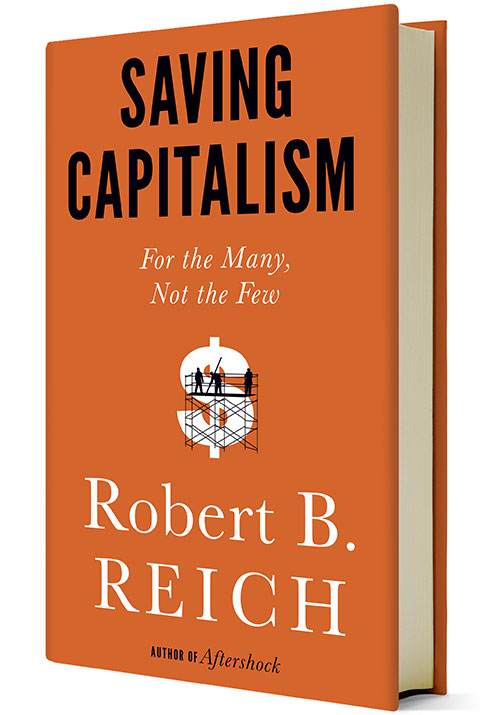
Saving Capitalism – For the Many not the Few is the latest addition to Robert Reich’s cohort of publications. He is perhaps best known for his previous work, The Work of Nations (1992) which raised the issue of growing inequality to the public sphere. Alongside his writing, Robert Reich is also a Professor at the University of California, Berkeley, and has served in various positions under the administrations of Gerald Ford and Jimmy Carter. Most notably, he was US Secretary of Labour under the Presidency of Bill Clinton between 1993 – 1997.
At the age of 71, Reich brings a lifetime of experience in both academia and politics to the table. As a true social-democrat, Reich’s Saving Capitalism is a continuation of the themes he discusses in previous publications – some of which include: rising inequality, the not so ‘free’ marketplace, the over-concentration of political and economic power in the hands of a few, the disenchantment of the masses, and others.
As the title may suggest, Saving Capitalism is a critique of the free market structures and modern-day capitalism. Reich argues that decision-making power is increasingly concentrated in the hands of a few, at the expense of the ‘many’. The very rich get richer and more powerful, while the middle and lower classes get weaker and poorer. The entire system is rigged against the majority in favour of a concentrated few. The solution to this injustice, Reich suggests, is an “…activist government that raises taxes on the wealthy, invests the proceeds in excellent schools and other means people need to get ahead, and redistributes wealth to the needy” (page xvii).
Does this narrative sound familiar? To many it certainly will. Robert Reich’s Saving Capitalism is therefore one among numerous publications that champion the social inequality-class warfare thesis. In that sense, the book brings little to nothing new to the debate. Nonetheless, it is well-written and its use of colloquial language grapples the reader. This does however make the book read like more of a socio-political novel rather than a macroeconomic or political account. One cannot help but feel that Reich’s desire to push his own personal narrative has come at the expense of rigorous analysis.
But before jumping to any conclusions, let’s briefly touch upon the structure and content.
Saving Capitalism is comprised of three main parts. The first chapter, entitled “The Free Market” aims to show how in fact ‘free markets’, are not ‘free’ (page 85).
As you may have already guessed, Reich argues that this is due to them being controlled by a select, powerful few that both establish and control rules in which a ‘free market’ operates. He argues that there are five ‘building blocks’ of a free market: property, monopoly, contracts, bankruptcy and enforcement. Each of these require human governance and can be used to either, promote a fair and decent society or can be manipulated to benefit a select few (page 9). This first part of the book argues that the latter has occurred. The stronghold on patent laws by pharmaceutical companies, the large lobby budgets of corporations to maintain dominant market positions, the abuse of bankruptcy laws, are all cited as evidence that the entire system is rigged in favour of on elite few.
The second part of the book is dedicated to showcasing the consequences of such a rigged system. Here Reich argues that free market meritocracy is in fact, a myth. Those at the top increase their own wages whilst those at the middle and bottom see their wages stagnant and in many cases, decline (pages 134-167).
In the third and final chapter, Reich argues for a restoration of countervailing power, or in layman’s terms, bringing power back to the people. The means by which he believes this can be achieved are certainly not new: an increase in the minimum wage, amending labour laws to favour unions, and changing contract laws as to encourage employees and workers to take action against unjust employers (pages 153 – 217).
So while Robert Reich’s latest work presents a compelling critique of the challenges facing 21st century capitalism, it brings little new to the table. Moreover, any truly impartial reader that has some basic understanding of economics would be quick to observe that Saving Capitalism is unabashedly lopsided. There is no doubt that western capitalism is at a crossroads, and the aftermath of the financial crisis has left millions feeling disenfranchised. However, Robert Reich portrays injustices within the free market (as real as they may be), as characteristic of the entire economy. It’s a bit like saying, we can’t play football anymore because one of the players faked an injury.
He also seems to portray an over-the-top form of class warfare: the elite vs. the rest. As if the classes are statutory and unitary groups with no movement or change between. The rich and powerful only stay rich and powerful while the rest suffer the consequences of their actions. We know this is simply not the case – a free market economy does indeed reward creativity and work. Whether, intentional or unintentional, Reich left out any deeper economic discussions, such as aggregate supply/demand and its impact on market meritocracy. This brings us to what is perhaps the most significant pitfall of the book, it is far to rooted in empirical storytelling rather than political or economic analysis. No matter how broad Robert Reich’s experience may be, personal examples should always be an addition to the argument and not its foundation.
Having said that, Saving Capitalism offers some captivating thoughts on the current state of free market. Provided that its rather superficial and politicised arguments are viewed through a critical lens, the book is certainly a worthwhile read.
“Saving Capitalism: For the Many, not the Few” was published in 2016 by Icon Books Ltd. (ISBN: 9781-78578-0677). 279pp.
 Andrei Rogobete is a Research Fellow with the Centre for Enterprise, Markets & Ethics. For more information about Andrei please click here.
Andrei Rogobete is a Research Fellow with the Centre for Enterprise, Markets & Ethics. For more information about Andrei please click here.

For the Least of These comprises a collection of short essays. Its purpose is clearly articulated by Arthur Brooks in the first paragraph of the Foreword: “The Christian Gospels make it abundantly clear that Jesus called on us to care for the poor. What is not at all clear, however, is the best means by which Christians living in a modern, industrial society … can and should carry out the Lord’s directive. This volume takes on the challenge of beginning to answer that question” (page 7).
The book seeks to fulfil its task through twelve chapters grouped under three headings: “A Biblical Perspective on the Poor”; “Markets and the Poor”; and “Poverty Alleviation in Practice”. As might be anticipated by those aware that its editors are Vice-Presidents of the Institute for Faith, Work & Economics, its basic thesis is that a free market economy is the best foundation for the alleviation of poverty. The authors are careful to avoid suggesting that the market automatically provides the solution or that the market is in some way an end in itself but they see it as having inherent potential. As Robert Sirico puts it in his chapter, “The price system in a free economy does not provide a moral foundation for a society. It does not remove opportunities for ill-gotten gain. What it does do is beat every form of socialism at generating moral socially beneficent options for escaping poverty” (page 179).
Negatively, the authors take issue with what Jay Richards (in the Conclusion) calls the “untutored intuition” that “if there are some rich people and some poor people, we can cure poverty by taking some of the wealth of the rich and giving it to the poor” (page 247). It is suggested that both government action (e.g. foreign aid) and some charitable activity (e.g. some gifts by churches to support people in the third world) is misconceived, if well meaning.
Positively, the promotion of trade and enterprise is advocated as the best long-term solution to poverty. For example, Brian Griffiths and Dato Kim Tan suggest that “Intentionally building a new factory close to a slum, creating jobs, and contributing to the local economy through its monthly wage bill, is far more effective in tackling poverty than all the CSR activities that companies can ever do” (page 145).
Most of the book is relatively high level. There are some interesting specific proposals for change. For example, Griffiths and Tan suggest that it is illogical to allow tax deductions for donations to charity but not to apply the same tax incentives to impact investing that builds social enterprises among the poor (page 151). However, proposals of this kind are few and far between. This is a pity since the inclusion of some more would have improved the book. In particular, the book’s suggestion that a lot of government action has produced drug like dependency cries out for proposals as to how the patient should undergo detoxification without dying in the process! On the other hand, the authors might legitimately respond that it is necessary to win the conceptual battle at the macro level before moving to the detail and that this is a small book devoted to that conceptual battle. Furthermore, by its very nature, a market based approach is likely to involve a multitude of approaches informed by general principles rather than large over-arching policies centrally implemented. That, indeed, is one of its advantages.
Of course, the essay format has some drawbacks. In particular, as might be expected in a book with fourteen different contributors, the arguments are not developed in a linear manner, the chapters overlap and not all of the arguments are consistent with one another (e.g. there are differences of view as to how bleak or otherwise the outlook for global poverty really is and different levels of optimism are expressed regarding micro-finance initiatives). In addition, some of the authors have tried to cram too much into their chapters, with the result that they are longer on assertion than argument and adopt language which, at least to UK ears, is unduly polemical (e.g. Jay Richards won’t win many friends by suggesting that Lyndon Johnson’s “War on Poverty” could just as well be called the “War on the Poor”, page 250).
Most readers will want to take issue with at least some of the arguments that are advanced, although they may not agree which arguments should be challenged! For example, David Kotter’s distinction between “wealth” and “riches” (page 60) and Robert Sirico’s suggestion that something is disordered “when it is imbalanced and disregards reason as well as the mandate of scripture” (page 176) are contentious interpretations of the bible. More generally, with the exception of Brian Griffiths, Dato Kim Tan and Richard Turnbull, all of the authors are based in the USA and the book has a clear US perspective. Indeed, some of the chapters relate almost entirely to the US experience (e.g. Anne Bradley’s chapter on Income & Equality). This US experience is important and interesting. There is much to learn from it. However, it would be good to consider other perspectives.
That said, each author contributes something worth thinking about and some of the contributions are very good: the chapters examining historic attitudes and actions in the UK and the USA (by Richard Turnbull and Mark Isaac, respectively) are particularly interesting since they allow the past to challenge contemporary attitudes; Art Lindsley’s short chapter on wealth redistribution comprises a concise demolition of superficial interpretations of the Old Testament Jubilee laws and of the practices of the New Testament Church; and Marvin Olasky’s chapter on the US welfare system, although in some respects perhaps over journalistic, raises a number of issues that deserve careful consideration.
For the Least of These is not a book for those looking for careful engagement with academic debates. Those looking for a systematic explanation of the potential of the free market to alleviate poverty should also look elsewhere. However, it is well worth reading. Few readers will come away without being challenged in some respect and the range of subjects covered should be a spur to further reading and thought.
“For the Least of These” was published in 2014 by Zondervan (ISBN – 10: 0310522994). 252 pages (excluding notes and glossary).
 Richard Godden is a Lawyer and has been a Partner with Linklaters for over 25 years during which time he has advised on a wide range of transactions and issues in various parts of the world.
Richard Godden is a Lawyer and has been a Partner with Linklaters for over 25 years during which time he has advised on a wide range of transactions and issues in various parts of the world.
Richard’s experience includes his time as Secretary at the UK Takeover Panel and a secondment to Linklaters’ Hong Kong office. He also served as Global Head of Client Sectors, responsible for Linklaters’ industry sector groups, and was a member of the Global Executive Committee.
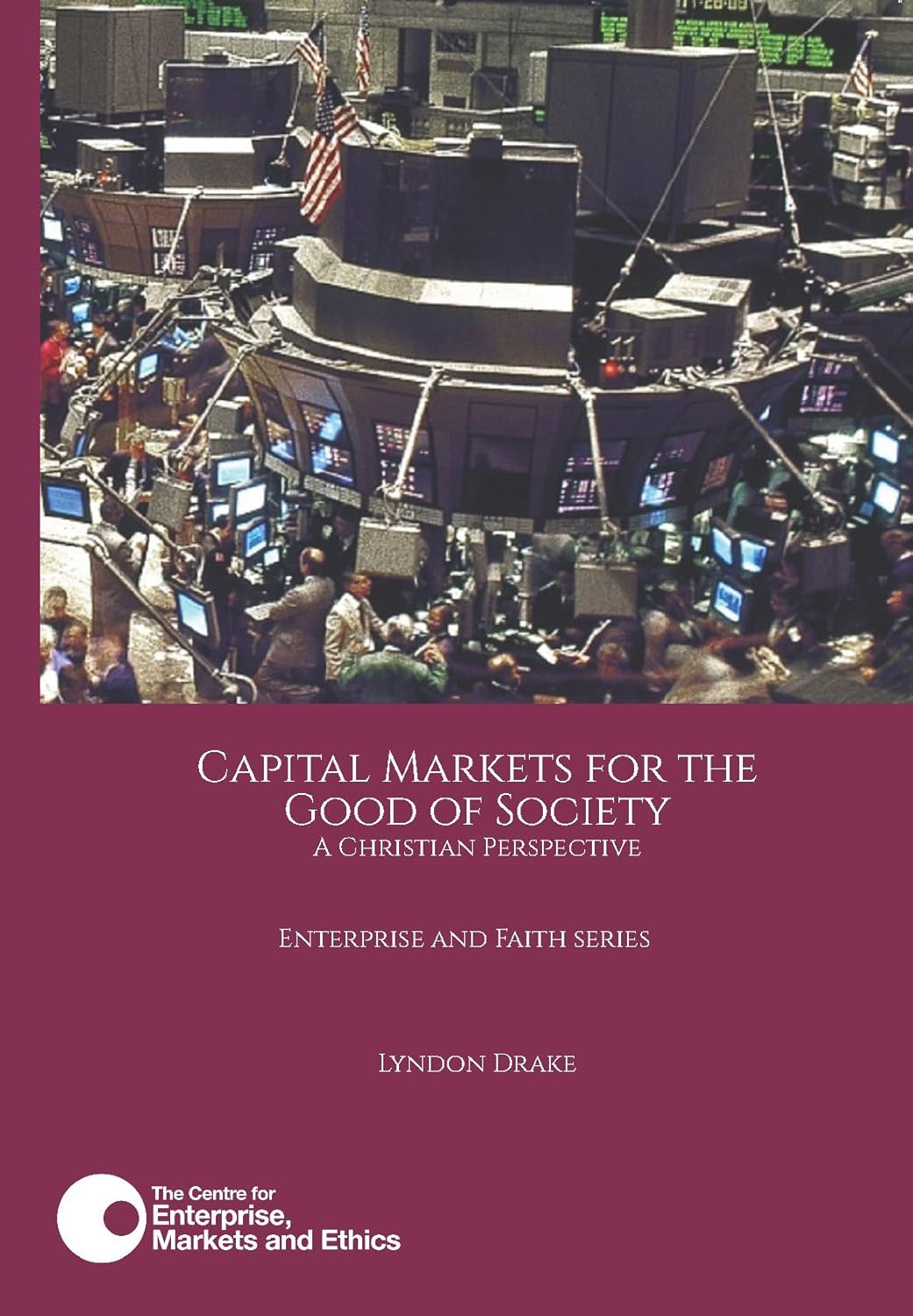
The Centre for Enterprise, Markets and Ethics (CEME) is pleased to announce the publication of Capital Markets for the Good of Society: A Christian Perspective by Lyndon Drake.
The publication can be downloaded here. Alternatively, paperback copies can be ordered by contacting CEME’s offices via email at: office@theceme.org
An event associated with this publication was held in November 2017
About the Publication
Capital Markets for the Good of Society discusses the ethical foundations and societal benefits of capital markets from a Christian perspective, emphasizing their role in promoting human flourishing and economic fairness.
About the Author
Dr. Lyndon Drake (PhD, Computer Science, York; MA, Theology, Oxon) is a research student at the University of Oxford, working on a biblical theology of capital. Until 2010, Lyndon was a Vice President at Barclays Capital, trading government bonds and interest-rate derivatives. He now chairs the Council for Business and Theology (part of the Business Coalition of the World Evangelical Alliance), and has served as pastor of a city centre church in New Zealand, as well as teaching the theology of work at seminaries and serving in regional church leadership.

This book is a collection of previously published articles and one unpublished conference paper, with a new 46 page long introduction. It is therefore not a book that develops an argument skillfully and steadily, rather it hammers away at certain themes, sometimes repetitively. Streeck acknowledges this in his Note on the Text, where he admits to an ‘occasional overlap between chapters’ (p. ix). Having read through them all I did feel that at times this repetitiveness was unfortunate, although there is undoubted value in having the various articles gathered in one place.
The organizing theme taken by Streeck is that capitalism is collapsing because of certain internal contradictions. What is more, the author believes that we are living in a period of ‘deep indeterminacy’ (p. 12) in which it is difficult to predict what will happen, and that there is nothing obvious to replace our contemporary capitalist system. Other than at two brief moments, the prophetic message given is one of doom and gloom throughout the entire book, with no real sense of hopeful possibilities. In an emotional sense, and perhaps also because of its repetitive nature, I therefore found that reading this book left me dispirited, but also with a sense that the analysis might be incomplete or flawed.
One of the recurring strands running through the book is that of the relationship between economics and sociology. This is addressed through the lenses of economic history, the nature of money and debt, the difficult relationship between capitalism and democracy, commodification and inequality, and a consideration of the class structures within society (Marx certainly gets several mentions). This is summarized admirably concisely and clearly in the final paragraph of Chapter One, which bears the same title as the book itself, and which started life as a lecture given at the British Academy on 23rd January 2014.
At heart, although he never exactly states it in this way, Streeck presents a vision of capitalism as an epoch within history, whose time was always going to be limited, rather than accepting a view of history that must fit within a capitalistic meta-narrative. In order to sustain this argument, the author needs to describe capitalism in a certain, rather dysfunctional, way. So for example, Streeck sees innovation as something that ‘attacks and destroys in particular firms and markets that operate to everybody’s satisfaction.’ (p. 39) I was not convinced by this. It seemed to me that the author’s structuralist view of society had left little space for human creativity, and left him unable to see individuality as anything except a problem. However, prompted by Streeck’s analysis I did find myself asking about the nature of a wholesome vision of collective life within which individuals can flourish, and what kind of ‘progress’ this would mean.
The two moments, hinted at above, when Streeck himself ventures into the territory of suggestions or answers to these questions come at the end of Chapters Eight and Nine. Chapter Eight considers the troubled relationship between democracy and capitalism, taking the work of Wolfgang Merkel as a foil, but I was heartened to discover the suggestion of ‘de-globalizing capitalism’ (p. 198) and the idea that ‘restoring embedded democracy means re-embedding capitalism’ (p. 199) (italics in the original). For me, this idea offers the genesis of a new piece of work, different in tone to the current collection, and I would encourage Streeck to reflect on how this could be developed. Rather different, but equally important, is the moment at the end of Chapter Nine when Streeck feels for ‘…a non-capitalist politics capable of defining and enforcing general interests in the sustainability of human society’ (p. 225). I took this to be a call for the complex relationship between politics and economics to be re-imagined.
This brings me to another problem that I had with this book; it has in a sense been overtaken by the events of the Brexit referendum and the election of Donald Trump. The relationship between politics and economics is being re-drawn before our eyes, the old assumptions are unraveling, and faltering attempts at what could be called a ‘non-capitalist politics’ are emerging. I feel sure Streeck must now be writing something new, and I would encourage him to do so. From a Christian perspective, deep questions of identity connected to the individual and to society are very resonant with theological reflections on the nature of life itself, and the way in which societies and economies are arranged. I was therefore pleased to have been stimulated in my own thinking as I read this book. I look forward to a more cohesive, less repetitive, and post-Brexit sequel.
The book is nicely presented with a good index. The author is the Director of the Max Planck Institute for Social Research in Cologne and Professor of Sociology at the University of Cologne.
How Will Capitalism End? Essays on a Failing System – by Wolfgang Streeck, 2016, ISBN 13: 978-1-78478-401-0
Edward Carter is Vicar of St Peter Mancroft Church in Norwich, having previously been the Canon Theologian at Chelmsford Cathedral, a parish priest in Oxfordshire, a Minor Canon at St George’s Windsor and a curate in Norwich. Prior to ordination he worked for small companies and ran his own business.
He chairs the Church Investors Group, an ecumenical body that represents over £10bn of church money, and which engages with a wide range of publicly listed companies on ethical issues. His research interests include the theology of enterprise and of competition, and his hobbies include board-games, volleyball and film-making. He is married to Sarah and they have two adult sons.
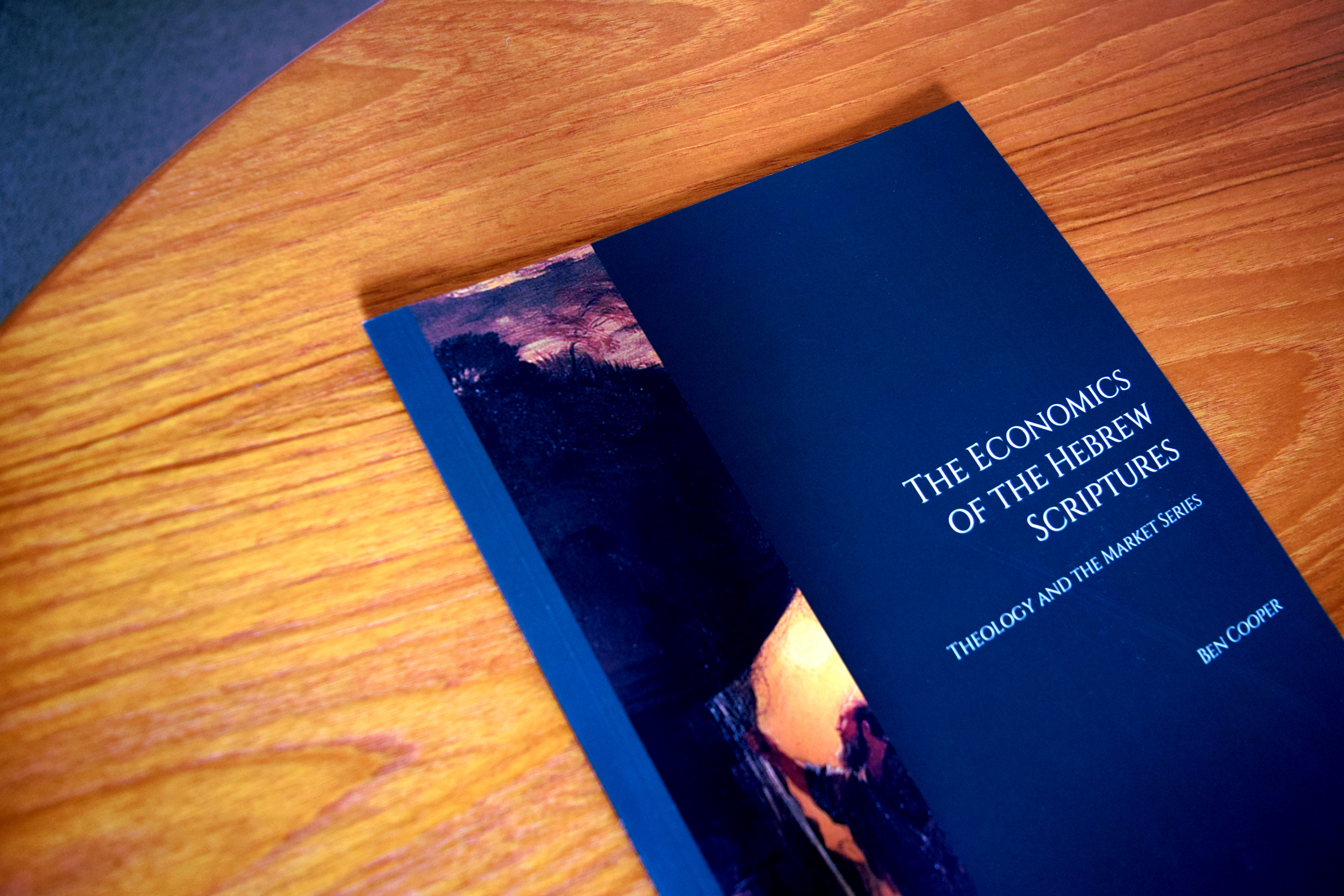
The Centre for Enterprise, Markets and Ethics (CEME) is pleased to announce the publication of The Economics of the Hebrew Scriptures by Ben Cooper.
The publication can be found here.
Alternatively, for hardcopies please contact CEME’s offices via email at office@theceme.org

This is an excerpt from the The Mais Lecture: Restoring Trust in the Banking System at Cass Business School, May 24th 2017. For the full text, please click here.
It is a great honour to be invited to deliver the Mais Lecture this year, the 38th occasion on which it has been given. It is also a particular personal pleasure.
I was appointed to the Chair in Banking and International Finance at The City University in 1976. The funds for the chair had been raised by a previous Lord Mayor, Lord Mais and so out of recognition for his contribution I felt it appropriate that we establish a lecture in his honour. Hence the Mais Lecture.
The first Mais lecture was given in 1978 by Sir Gordon Richardson, the then Governor of the Bank of England, who told me that it was the first time a Governor of the Bank of England had set out in detail the design and implementation of UK monetary policy. The event was a huge success and the text of the lecture was reproduced in full the following day in The Times newspaper. (The lecture has subsequently been given by central bank governors, finance ministers, prime ministers, a French president, a journalist, a chief rabbi and a number of distinguished academic economists including Frederich von Hayek and Lord Robbins. This year I’m afraid you come down to earth!)
The subject I have chosen for this lecture is restoring trust in the banking system and by the banking system I mean central banks, bank regulators and commercial banks. I should make it very clear that this lecture is my own personal view and not that of Goldman Sachs, though I acknowledge a great debt to my colleagues at the firm for their valuable insights.
Since the financial crisis began in 2007 the reputation of the City, and trust in the banking system, have never been more challenged. The UK Parliamentary Commission on Banking Standards described the crisis as “a collapse of trust on an industrial scale.” (Paul Tucker, A deputy governor of the Bank of England has described (with hindsight) the associated failure of regulation as “shocking, astonishing…catastrophic” which “left the credibility of financial regulation in tatters!” (Paul Tucker, Brookings Institution, Regulatory Reform, Stability & Central Banking, January 2014)). A review of what went wrong in one major UK commercial bank concluded that trust in the commercial banks had been “decimated” by the crisis.
(The pre-crisis factors which led to this loss of trust have been well documented in books and research papers and commented on in plays, novels, films and the news media by academics, journalists, novelists, playwrights and filmmakers.) Since the crisis each of the countries involved has undertaken a sweeping review of its regulatory structures, resulting in the creation of new institutions (the PRA and FCA in the UK), new regulations (covering capital, liquidity, compensation, resolution planning, governance and conduct) and more comprehensive and intensive supervision (UK Senior Managers Regime). Internationally, countries have worked together through the G-20 Financial Stability Board to facilitate harmonization and cross border regulation.
Yet ten years later and after this immense effort, trust remains low. Only 20% of the UK population think banks are well-managed, down from 80% in the 1980’s. (In a recent survey in Germany only 26% of the population expressed confidence in the banking system). The independence of central banks has been challenged in the US, the Eurozone, Japan and the UK. The view of the new regulatory structures by academics and commentators is ‘could do better’.
(One respected commentator concluded a recent piece on the UK claiming “the haze of mistrust continues to hang over the whole City”, (Juliet-Samuels, D-T, 7th April 2017), while in the US context another remarked that “the world has not come to terms with the crisis of 2008. Justice has not been seen to be done. Remedies to prevent a repeat have not been seen to be applied. Dodd-Frank has failed to instill confidence.” (John Authers, F.T., April 15th 2017))
If a modern advanced economy is to function effectively it needs a sophisticated financial system which is trusted by the public. They must believe that it benefits society as a whole, and not just bankers. They must believe that the services sold by banks are appropriate to their needs and competitively priced. They must have faith in the competence and integrity of bank leadership, and respect for banks’ corporate cultures. The financial system must be seen as making a contribution to society, not being an island within it.
Against this backdrop I wish to explore three challenges which I believe must be met if trust is to be restored and maintained in the banking system.
To continue reading the full text of this lecture, please click here.
Lord Griffiths is the Chairman of CEME. For more information please click here.
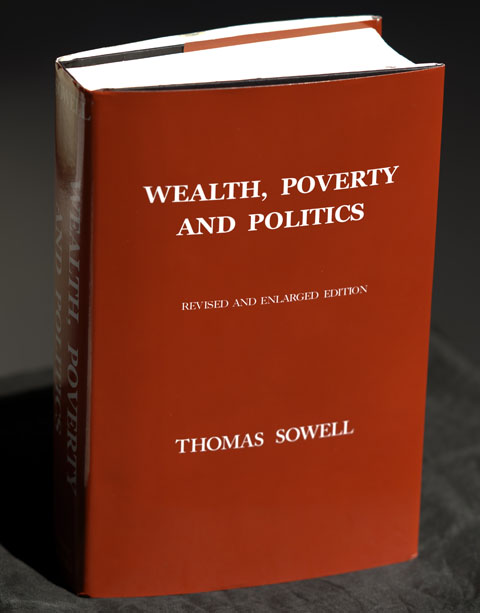
How much of modern Western social and economic policy is based on properly interpreted factual evidence and how much on unexamined assumptions and ideology? In Wealth, Poverty and Politics, Thomas Sowell, the venerable Senior Fellow at the Hoover Institution at Stanford University, sets out to demonstrate that rather more than is healthy is based on the latter.
Sowell divides opinion. He shuns labels but he is a hero of those on the right who favour small government and free market policies. Conversely, he is castigated as a villain by those on the left, although since he is black and was brought up in poverty in North Carolina in the days of segregation, he is a rather unusual villain!
Wealth, Poverty and Politics is unlikely to lessen this division of opinion. It largely repeats things that Sowell has been saying for decades and sets out to slay a number of liberal sacred cows, ranging from affirmative action, through the welfare state to foreign aid.
Sowell’s starting proposition is that, because the humanitarian goals underlying many policy proposals are important, “it is crucial that these proposals be based on an understanding of the actual facts about the causes and consequences of economic inequalities” (page v). He then considers the role of geography, cultural factors, social factors and political factors, recognising that they overlap and interact with one another .
At a high level of generality, all of this is unexceptional. It is when Sowell begins to consider its implications that the radical nature of what he is saying becomes clear. He takes issue with those who start with the premise that “the poor are poor because they are exploited by the rich” (page 257), a view that he demonstrates failed to die when Communism collapsed a generation ago. He takes issue with those, such as Professor Angus Deaton and the late Professor John Rawls, who equate equal prospects of success with equal opportunity, suggesting that Angus Deaton’s statement that there would be no correlation between the earnings of parents and their children in a society with perfect equality of opportunity “is in defiance of both heredity and environment” (page 180). He points out that, even in a society with perfect equality of opportunity, the factors that he identifies are likely to prevent an equality of outcomes.
Specifically, he points out that all cultures are not of equal economic value: “different groups living in the same external environment can have very different productivity if their internal cultural values produce very different priorities as to what they want to do, and at what sacrifices of other things” (page 97). He draws attention to differences in attitudes to learning (provocatively noting that, in the USA black parents in the highest socio-economic quintile have slightly fewer books in their homes than white parents in the lowest socio-economic quintile), differences in attitudes to work (noting that whole societies, such as Spain in the 16th to 18th centuries and the Southern States of the USA until recent times, have regarded work as degrading) and differences in ambition (noting that some social groups, including some white groups in the UK, lack ambition). Perhaps most controversially of all, he suggests that some groups have greater mental capacity than others, although he is careful to stress that the evidence suggests that this is not to do with genetic pre-conditioning but cultural and social factors.
Sowell suggests that “the ultimate wealth of a society does not consist of its tangible output, as such, but the ability – the human capital – to produce that tangible output” (page 413) and that the failure to recognise this leads policy in the wrong direction: efforts to advance economically lagging groups should be directed not so much at correcting society and its institutions as “getting members of lagging groups to reorientate themselves towards acquiring more human capital” (page 181). This is perhaps best summed up in Henry Hazlitt’s statement that “The real problem of poverty is not a problem of distribution but of production” (page 8).
On this basis, Sowell attacks modern liberal economic and social policy. He lays into US welfare policy, suggesting that it produces counter-productive lifestyles that reduce the need to develop essential human capital and that “having promised progress towards ‘social justice’” it has “delivered instead retrogressions towards barbarism” (page 305). Foreign aid, affirmative action and identity politics are dealt with in a similarly robust manner (e.g. he suggests that multi-culturalism “has often been carried to the point of encouraging lagging groups to proudly cling to their own culture, or even resurrect it in some cases, with little concern that these groups’ economic and educational lacks might be – at least in part – a result of the cultures that they were being encouraged to cling to”, page 166).
Wealth, Poverty and Politics has significant defects. Its argument does not develop in a clear linear manner and it would benefit from severe editing, since many points are made on more than one occasion and some on multiple occasions (e.g. Sowell’s point regarding the lower I.Q.’s of mountain based people). It would also benefit from the inclusion of positive suggestions for policy that interact with the moral issues raised by poverty.
These issues are annoying but Sowell writes in an engaging manner. He has a penchant for quotable quotes and, more importantly, an ability to provide thought provoking illustrations of the points that he is making drawn from a variety of different places around the world and a variety of different periods and contexts in the past 1000 years. This results in interesting comparisons (e.g. between some black communities in the USA and low-income white communities in the UK and between early modern Spain and the contemporary Middle East). Furthermore, his use of statistics is sufficient to back up his arguments without overwhelming the reader and the addition of a number of personal anecdotes adds a human dimension.
The result is a readable book aimed at the intelligent non-specialist that raises issues of critical importance in the West today. Many on the left will want to take issue with what Sowell says but they will need to demonstrate why he is wrong. Many on the right will agree with much of what is said but even they will need to ask themselves whether their policy prescriptions might be counter-productive.
The revised and expanded edition of “Wealth, Poverty and Politics” was published in 2016 by Basic Books (ISBN-10:0465096763). 565 pp.
 Richard Godden is a Lawyer and has been a Partner with Linklaters for over 25 years during which time he has advised on a wide range of transactions and issues in various parts of the world.
Richard Godden is a Lawyer and has been a Partner with Linklaters for over 25 years during which time he has advised on a wide range of transactions and issues in various parts of the world.
Richard’s experience includes his time as Secretary at the UK Takeover Panel and a secondment to Linklaters’ Hong Kong office. He also served as Global Head of Client Sectors, responsible for Linklaters’ industry sector groups, and was a member of the Global Executive Committee.

Carbon Trading – Unethical, Unjust and Ineffective? by Cameron Hepburn was presented at the “Green Markets, Sustainable Business” conference on Thursday 2nd March 2017, at One Great George Street, London.

In 1987 ICI, one of the leading chemical conglomerates at the time, described its purpose as follows:
ICI aims to be the world’s leading chemical company serving customers internationally through the innovative and responsible application of chemistry and related science. Through the achievement of our aim we will enhance the wealth and well-being of shareholders, employees, customers, and communities which we serve and in which we operate.
In 1994 the company objective had changed to:
Our objective is to maximise value for our shareholders by focussing on businesses where we have market leadership, a technological edge, and a world competitive cost base.
So, what changed? What changed so that ICI no longer aimed to be the world’s leading chemical company? What changed such that ICI’s application of science was no longer to be the innovative and responsible application of chemistry and related science, but only that in which they had a technological edge? What happened to the employees, customers, and communities which we serve, to be replaced by to maximise value for our shareholders?
The answer requires a book rather than a blog but the case of ICI is illustrative of the way in which business has become separated from ethics, values and a truly holistic purpose which historically served the economy and society well.
The Quakers represented, in 1850, no more than one half a percent of the population. Thus it is even more extraordinary just how many of our household names had Quaker origins – not least in financial services – Barclays, Lloyds, Friends Provident, Cadbury, Rowntree, Clarks (as in shoes), Huntley and Palmer (biscuits). The successful iron smelting that formed the basis of the Industrial Revolution came from a Quaker family, the Darbys.
I am not suggesting that the solution to the problems of business purpose and intent today is solved if we all became Quakers! However, what I am saying is that by understanding the key reasons why the Quakers were successful (mostly) in business can inform our contemporary debates in a helpful manner.
There were four key reasons behind Quaker business success, all of which have wider application today.
Entrepreneurs do not flourish alone. Professor Mark Casson of Henley Business School has argued that the quality of entrepreneurship depends upon the quality of business culture. A strong culture is built upon trust, confidence integrity and quality. The strength of the Quaker culture had a direct impact upon their business success. The Quakers – among others – had by 1800 faced around 150 years of oppression, crucially including exclusion from the Universities. Hence many Quakers turned their minds to business. This persecution made them close-knit communities and it was within this setting that apprenticeships were developed, trust and confidence built as the major families all knew each other, with dishonesty and especially bankruptcy viewed in highly negative terms due to the impact on Quaker reputation. A strong culture which enhanced positive behaviour of honesty and integrity (quality products at fixed prices) and discouraged negative behaviour.
A major complexity today is that we have become so individualistic that moral behaviour is reduced also to the behaviour of each individual. We need to recover not ‘moralising’ but ‘moral character’ and ‘moral action.’ The reality is that much of the Quakers integrity derived from their spiritual principles. Their moral codes included injunctions against overtrading, honesty, payment of debts, caution over indebtedness, transparent and accurate accounts and understanding of the business. These principles derive from the Quaker ‘Advices’ and ‘Queries’ on trade issued between 1675 and 1793. Many Quakers became wealthy, but often had to endure the long and patient wait of the entrepreneur for success. As a result, they were not ostentatious with their wealth and certainly exercised personal discipline and frugality in the wait for a return. There are clear lessons for us today and we must become more willing to talk about moral values.
Generally speaking, negative views of business are aimed at the big corporates and more positive views of business related to smaller, local and family businesses (SMEs). All the successful Quaker businesses began as family businesses. Indeed, most involved the capital of the founders and owners being placed at risk. The opposite of limited liability. Growth inevitably led to a dilution of the family business and the need for capital ultimately led the leading Quaker businesses to adopt limited liability. However, the idea of the family business lay at the heart of the Quaker vision. The business was seen as part of the family and as a result concern for both quality products and the employees – so, everything from sport, to societies, savings clubs but also pension funds, sick pay and even bonus schemes.
The compartmentalisation of business from society is disastrous. The Quaker businesses had a much more holistic view of their purpose. Profitability was essential, but so were reputation, customers and the society of which they were part. The days of company’s building model villages providing housing – not charitable, but commercial – as well as ensuring community green space, fresh air and light may be over but the principles still provide lessons. Social purpose and commercial profitability and success are not mutually exclusive. Real relationships – between owners and managers, managers and workers, companies and customers and so on – are infinitely more purposeful than the remoteness and the contractual nature of so many business relationships.
How far we have come. Without a sense of ethical responsibility, disciplined moral behaviour and character and a recognition that capital and its economic return carry responsibilities as well as rewards, we will continue to increase the divide of business and society. However, we must also recognise that all of this can only be achieved in the context of a free economy where wealth creation is celebrated rather than despised and where the limits of government are recognised to be as significant as its regulatory and redistributive roles. A concern for society and the responsibilities of wealth do not need to be separated from a wealth-creating, efficient business enterprise. Profit is virtuous, but does not need to be maximised at the expense of all other demands.
Culture, ethics, family relationships, purpose, values, employees, responsibility – for all these things we can thank, at least in part, the Quaker businesses. All of those things are essential in restoring confidence in business today.
 Dr Richard Turnbull is the Director of the Centre for Enterprise, Markets & Ethics (CEME). For more information about Richard please click here.
Dr Richard Turnbull is the Director of the Centre for Enterprise, Markets & Ethics (CEME). For more information about Richard please click here.
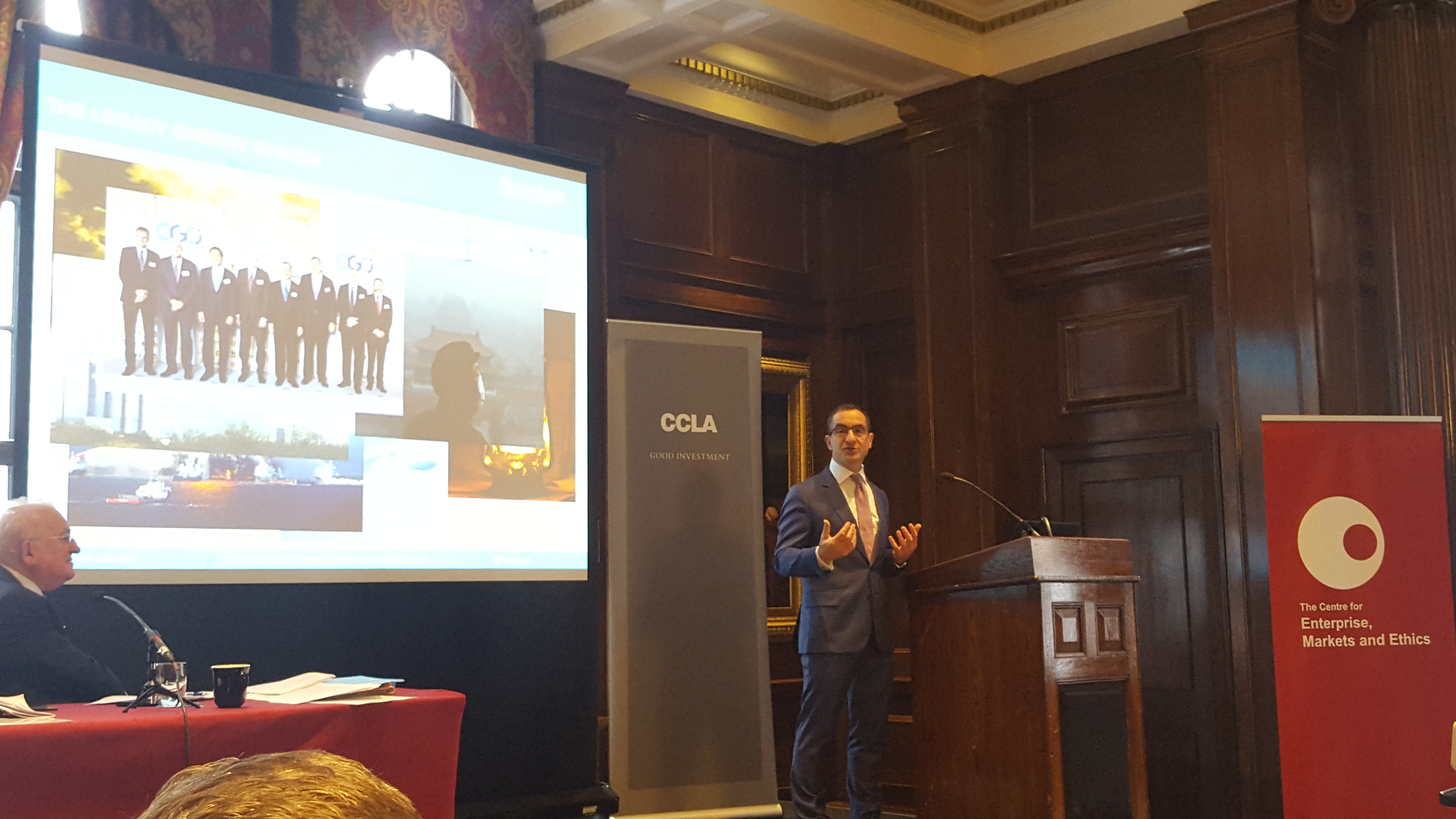
The Centre for Enterprise, Markets & Ethics (CEME) held a conference on ‘Green Markets, Sustainable Business’. Hosted by CEME and sponsored by CCLA Investment Management, the event focused on the green economy, investment trends in sustainable energy, and the environment.
It proved to be a terrific debate with passionate engagements from both the speakers and the audience. The distinguished panel of speakers included: Michael Liebreich (Chairman, Advisory Board, Bloomberg New Energy Finance), Rt Revd James Jones (Bishop of Liverpool 1998-2013), Baroness Bryony Worthington (Former spokesperson for Energy & Climate Change, Executive Director – Environmental Defence Fund Europe), Prof. David Vines (Ethics & Economics, University of Oxford), Andy Darrell, (Chief of Strategy, Environmental Defence Fund), Kingsmill Bond (Energy Strategist, Trusted Sources), and others.
The event took place on Thursday 2nd March 2017, at One Great George Street, London SW1P 3AA.
Andy Darrell – Investor Confidence
Michael Liebreich – Green Markets, Sustainable Business
Kingsmill Bond – The New Energy Revolution – From Morality to Market
Cameron Hepburn – Carbon Trading: Unethical, Unjust and Ineffective?
Erin Priddle – Environmental Defense Fund – EDF Oceans